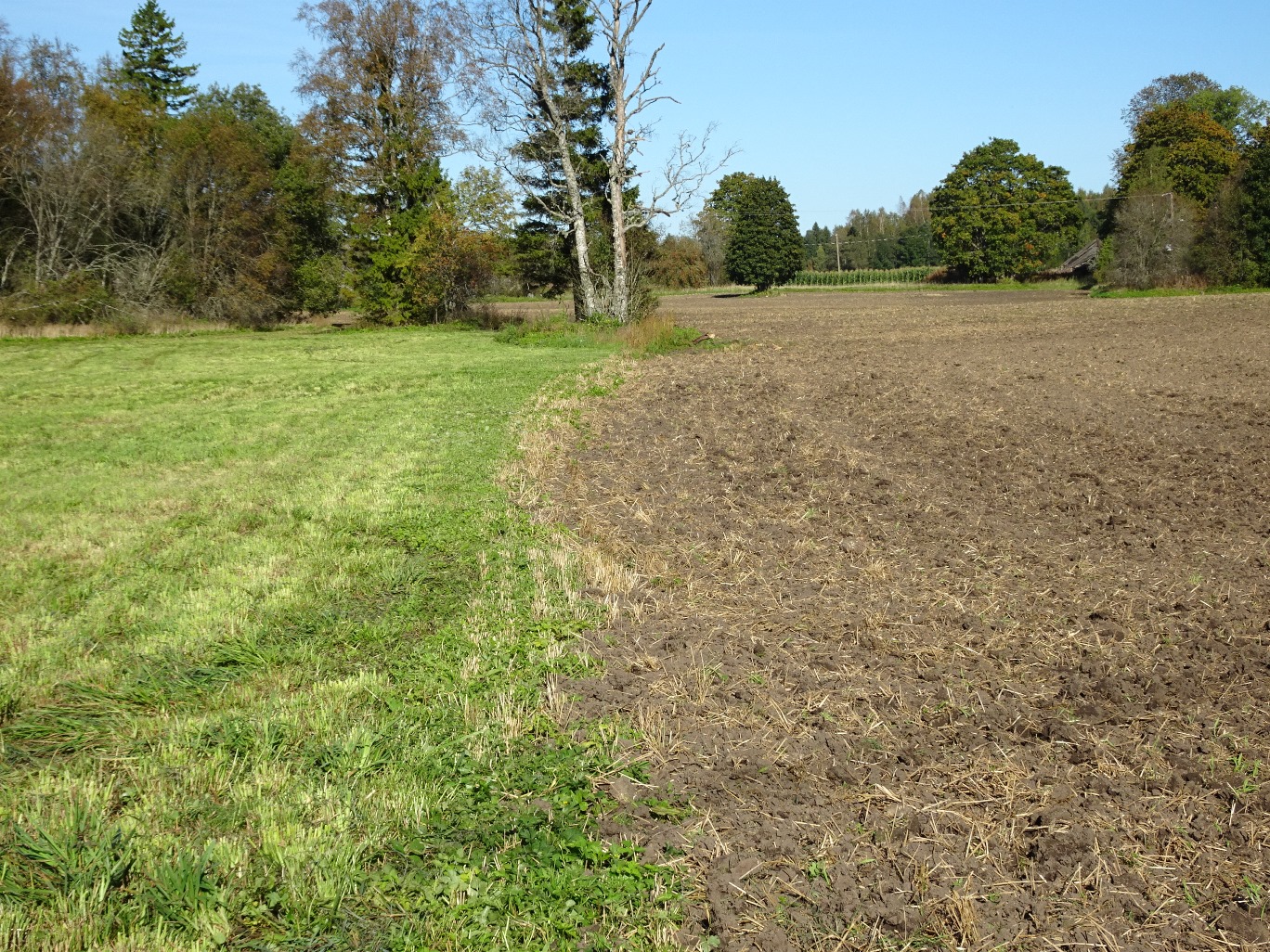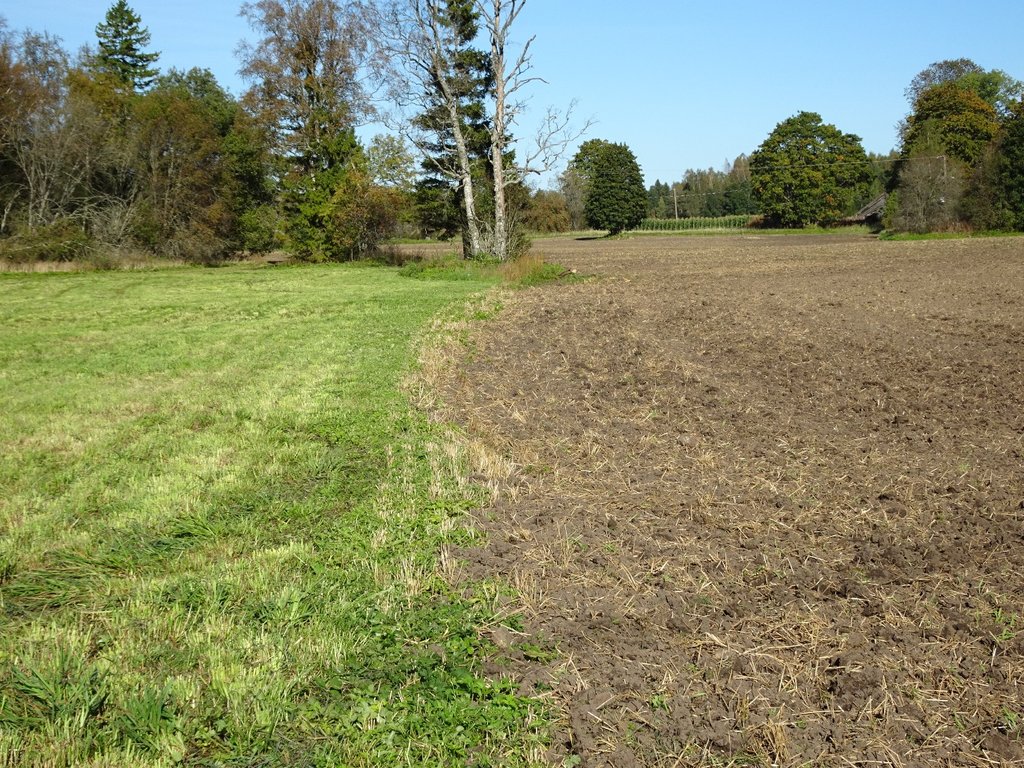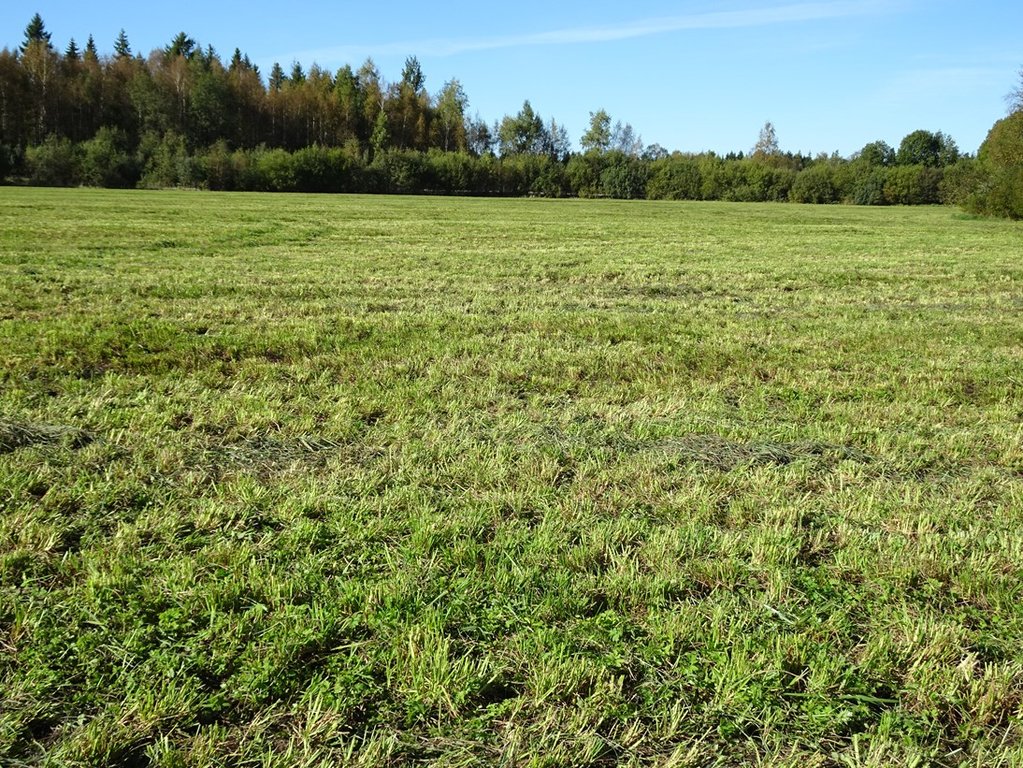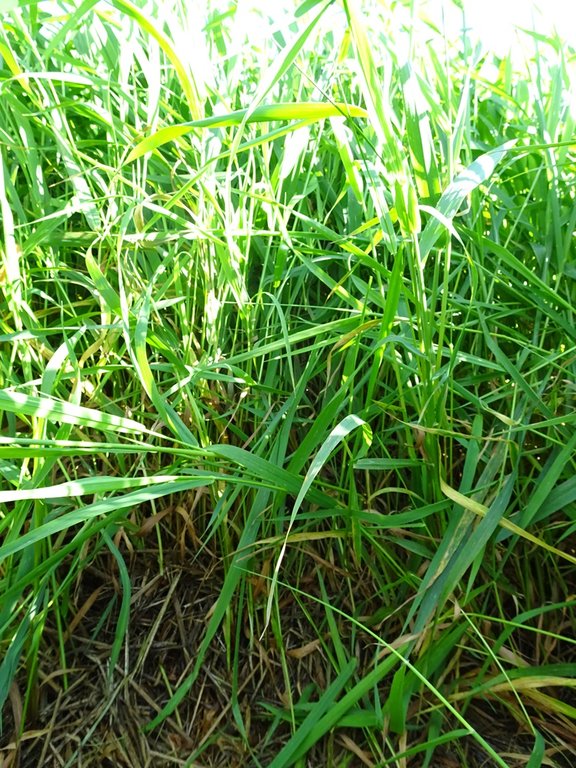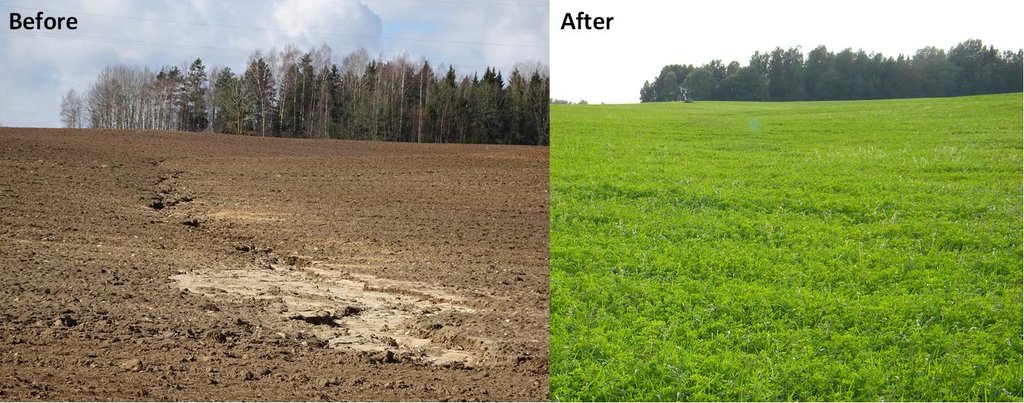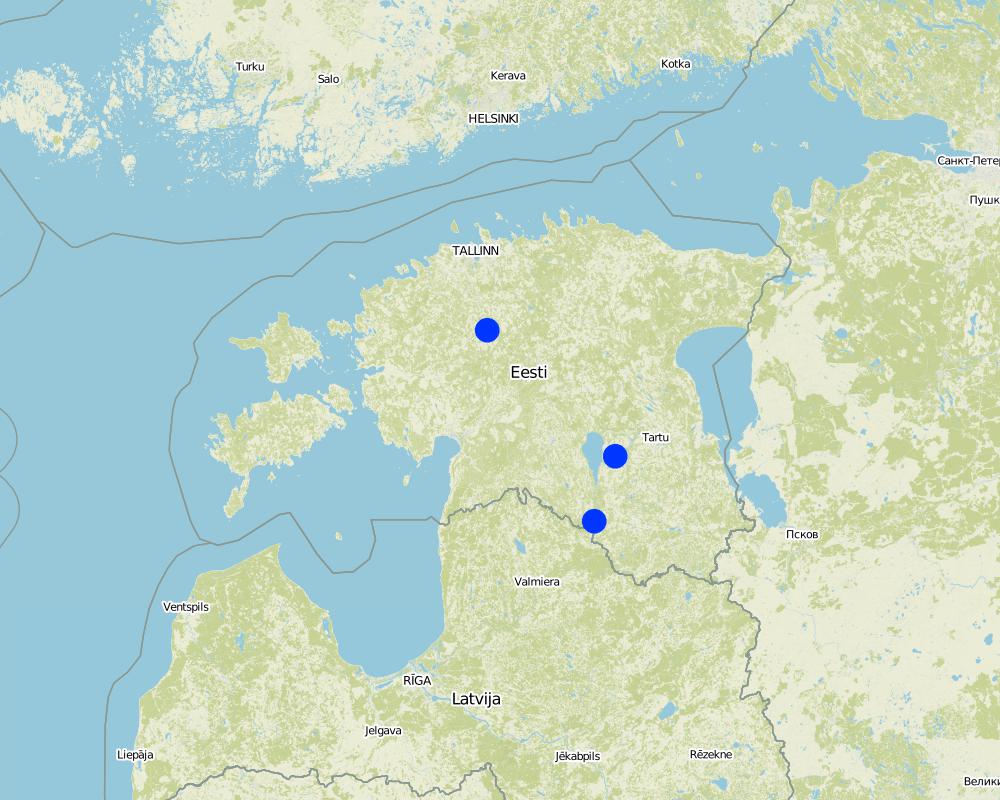Permanent grassland on peaty and eroded soils [Estônia]
- Criação:
- Atualização:
- Compilador/a: Endla Reintam
- Editor: –
- Revisores: Ursula Gaemperli, Gudrun Schwilch, Alexandra Gavilano
Püsirohumaa turvas- ja erodeeritud muldadel
technologies_3113 - Estônia
Veja as seções
Expandir tudo Recolher tudo1. Informação geral
1.2 Detalhes do contato das pessoas capacitadas e instituições envolvidas na avaliação e documentação da tecnologia
usuário de terra:
Selge Are
Hummuli Agro
Estônia
researcher:
Penu Priit
Agricultural Research Centre
Estônia
Nome do projeto que facilitou a documentação/avaliação da Tecnologia (se relevante)
Interactive Soil Quality assessment in Europe and China for Agricultural productivity and Environmental Resilience (EU-iSQAPER)1.3 Condições em relação ao uso da informação documentada através de WOCAT
O/a compilador/a e a(s) pessoa(s) capacitada(s) aceitam as condições relativas ao uso de dados documentados através da WOCAT:
Sim
1.4 Declaração de sustentabilidade da tecnologia descrita
A tecnologia descrita aqui é problemática em relação a degradação da terra de forma que não pode ser declarada uma tecnologia de gestão sustentável de terra?
Não
2. Descrição da tecnologia de GST
2.1 Descrição curta da tecnologia
Definição da tecnologia:
A permanent plant cover is maintained or established to protect soil against erosion or peat decomposition.
2.2 Descrição detalhada da tecnologia
Descrição:
The technology is applied in sub-humid climate with an average of 696 mm of precipitations per year, from which more comes from July to October and less in March and April. Average annual temperature is +4 C, length of the growing period is 180-195 days. The territory is mostly flat to slopes of 6-10%. Average altitude from the sea level is 50 m. About half of the Estonian territory is above 50 m and half is below it. Soils are from very shallow (less than 0.1 m) inthe north to very deep (> 120m ) in the south. Soil cover is very variable. The peat cover of peatlands varies from 0.3 m to more than 10 m from well decomposed to poorly decomposed peat. On hilly areas the soils are medium textured with low (< 1%) organic matter in topsoil. Groundwater in near the surface in peatlands and deep in hilly areas. Biodiversity of these areas is medium. Market orientation of production system is mixed and off-farm income less than 10%. Relative level of wealth is average from individual households to cooperatives. Soil management is mechanized. Land belongs to land users but is leased also in case of bigger farms (over 1000 ha).
In the agricultural land the area will be excluded from intensive tillage by establishing a permanent plant cover, mainly with grass. The aim is to protect the slopes over 10% against erosion and peaty soils from further intensive decomposition of organic matter and with that the reduction of CO2 emission. The farmers should maintain permanent plant cover in the areas mentioned, or establish permanent plant cover. Renewing of the grassland is allowed from the top (without ploughing) once in a 5 year period. Government pays support of 50 EUR/ha if the area is bigger than 0.3 ha. The technology reduces intensively tilled area and thus the possibility to grow cash crops and/or reduces the yield from grassland. On the other hand it allows to still use wet areas for agriculture (i.e. fodder production).
The rules of the technology are fixed with the Estonian Rural Development Plan (ERDP) for 2014-2020 under activity "Support for regional soil protection" (https://www.agri.ee/et/eesmargid-tegevused/eesti-maaelu-arengukava-mak-2014-2020) related to the reguation of the European Parliment and of the Council 1305/2013, article 28. The regulation is relevant more to the South-Estonia in case to reduce erosion, as the landscape is more hilly there. The exclusion of peatlands from agricultural use is relevant more in West-Estonia where the share of peatlands of the total area is the highest. However, it can be applied in whole Estonia if the area of peatland is bigger than 0.3 ha.
2.3 Fotos da tecnologia
2.5 País/região/locais onde a tecnologia foi aplicada e que estão cobertos nesta avaliação
País:
Estônia
Região/Estado/Província:
One site at Rapla, second at Tartu, third at Valga (erosion)
Especificação adicional de localização:
One site: Rapla county, Pae; second site Tartu county, Annikoru, third site Valga county, Hummuli
Especifique a difusão da tecnologia:
- Uniformemente difundida numa área
Se a área precisa não for conhecida, indicar a área aproximada coberta:
- 1-10 km2
Comentários:
To get the governmental support the area should be larger than 0.3 ha. Othervise the size is not important, depending on the area covered by hilly area or wet soils in the landscape.
In 2016 it was 10554 ha Histosols and only 40 ha of eroded soils covered with this technology in Estonia. This area excludes grasslands on another soil types. On specific sites: in Rapla county in Pae the size of the field is ca 3.2 ha, at Tartu county, Annikoru 2.8 ha.
Map
×2.6 Data da implementação
Caso o ano exato seja desconhecido, indique a data aproximada:
- 10-50 anos atrás
2.7 Introdução da tecnologia
- Governmental tool
Comentários (tipos de projeto, etc.):
The tool is a part of Estonian Rural Development Plan (ERDP) for 2014–2020 for soil fertility.
The survey was done by the Soil Survey Bureau of the Estonian Agricultural Research Centre (http://pmk.agri.ee/). The results presented here are partly from this survey and from the work done by the project iSQAPER.
3. Classificação da tecnologia de GST
3.1 Principal/principais finalidade(s) da tecnologia
- Reduz, previne, recupera a degradação do solo
- Atenuar a mudanças climáticas e seus impactos
3.2 Tipo(s) atualizado(s) de uso da terra onde a tecnologia foi aplicada
Uso do solo misturado dentro da mesma unidade de terra:
Sim
Especificar o uso misto da terra (culturas/ pastoreio/ árvores):
- Agropecuária (incl. agricultura e pecuária)

Terra de cultivo
- Cultura anual
Cultivo anual - Especificar culturas:
- cereais - cevada
- cereais - milho
- cereais - aveia
- cereais - centeio
- Legumes e leguminosas - feijão
- legumes e leguminosas - ervilhas
- culturas oleaginosas - girassol, colza, outros
- culturas de raiz/tubérculos- batatas
- vegetais - vegetais de folhas (saladas, couve, espinafre, outros)
- legumes - raízes (cenouras, cebolas, beterraba, outros)
- wheat
Número de estações de cultivo por ano:
- 1
Especifique:
For the cereals one harvest per year, for grasslands 1-4 cuts per year. For hay 1 cut, for silage 2-4 cuts depending on the year

Pastagem
Pastagem extensiva:
- Fazenda pecuária
Pastagem intensiva/produção de forragem:
- Pastos melhorados
Tipo de animal:
- gado - lácteo
- gado - carne bovina não-láctea
- ovelhas
Produtos e serviços:
- carne
- leite
3.3 O uso do solo mudou devido à implementação da Tecnologia?
O uso do solo mudou devido à implementação da Tecnologia?
- Sim (Por favor, preencha as perguntas abaixo com relação ao uso do solo antes da implementação da Tecnologia)

Terra de cultivo
Comentários:
Usually before the implementation of the technology the land was intensively tilled and used for annual crop plantation. After implementation the grasslands can be used for cutting and grazing.
3.4 Abastecimento de água
Abastecimento de água para a terra na qual a tecnologia é aplicada:
- Precipitação natural
Comentários:
On Histosols the groundwater is close to the surface.
3.5 Grupo de GST ao qual pertence a tecnologia
- Solo/cobertura vegetal melhorada
- Perturbação mínima ao solo
3.6 Medidas de GST contendo a tecnologia

Medidas agronômicas
- A3: Tratamento da superfície do solo

Medidas vegetativas
- V2: gramíneas e plantas herbáceas perenes

Medidas de gestão
- M1: Mudança no tipo de uso da terra
3.7 Principais tipos de degradação da terra abordados pela tecnologia

Erosão do solo pela água
- Wt: Perda do solo superficial/erosão de superfície

Erosão do solo pelo vento
- Et: Perda do solo superficial

Deteriorização química do solo
- Cn: declínio de fertilidade e teor reduzido de matéria orgânica (não causado pela erosão)

Deteriorização física do solo
- Pc: Compactação
3.8 Redução, prevenção ou recuperação da degradação do solo
Especifique o objetivo da tecnologia em relação a degradação da terra:
- Prevenir degradação do solo
- Reduzir a degradação do solo
4. Especificações técnicas, implementação de atividades, entradas e custos
4.1 Desenho técnico da tecnologia
Especificações técnicas (relacionada ao desenho técnico):
The requirements to create a permanent grassland depends on soil type.
Species mixture suitable for the permanent grassland on wet soils (Histosols): Bromus sitchensis 30%, Phalaris arundinacea 45%, Phleum pratense 20%, Poa pratensis 5%. Sowing rate 20 kg/ha.
For the drier areas (eroded soils) the next mixture is suitable: Dactylis glomerata 65%, Phleum pratense 26%, Poa pratensis 9%. Sowing rate 23 kg/ha.
Autor:
Endla Reintam
Data:
14/08/2017
4.2 Informação geral em relação ao cálculo de entradas e custos
Especifique como custos e entradas foram calculados:
- Por unidade de tecnologia
Especifique a unidade:
per hectar
Outro/moeda nacional (especifique):
EUR
Se for relevante, indique a taxa de câmbio do USD para moeda local (por exemplo, 1 USD = 79,9 Real): 1 USD =:
1,18
Indique a média salarial da mão-de-obra contratada por dia:
36-40 EUR/day + taxes
4.3 Atividades de implantação
| Atividade | Periodicidade (estação do ano) | |
|---|---|---|
| 1. | Tillage (ploughing, cultivation) | in spring |
| 2. | Collecting stones, slip (by demand) | in spring |
| 3. | Fertilization | in spring complex fertilizer |
| 4. | Sowing | in spring |
| 5. | Rolling | in spring |
| 6. | Cutting the weeds | during growth (summer) |
| 7. | Fertilization during growth period | after every cut of grass, if cutted grassland, N-fertilizer |
Comentários:
If renewing the grassland, there will be no ploughing, collecting the stones and sliping. Only chisel plowing and/or sowing with fertilization. If the grassland will be use for grazing, no need for fertilization during growth period.
4.4 Custos e entradas necessárias para a implantação
| Especifique a entrada | Unidade | Quantidade | Custos por unidade | Custos totais por entrada | % dos custos arcados pelos usuários da terra | |
|---|---|---|---|---|---|---|
| Mão-de-obra | Driver (machinery work) | person day | 0,5 | 36,0 | 18,0 | 100,0 |
| Equipamento | Equipment (machinery) cost on establishment year | year | 1,0 | 207,0 | 207,0 | 100,0 |
| Material vegetal | Seeds | kg | 22,0 | 2,47 | 54,34 | 100,0 |
| Fertilizantes e biocidas | Complex fertilizer | kg | 500,0 | 0,42 | 210,0 | 100,0 |
| Fertilizantes e biocidas | Ammonium fertilizer | kg | 100,0 | 0,33 | 33,0 | 100,0 |
| Custos totais para a implantação da tecnologia | 522,34 | |||||
| Custos totais para o estabelecimento da Tecnologia em USD | 442,66 | |||||
Comentários:
For tillage and other operations it is calculated 14-18 EUR/ha.
If to hire equipment the labour costs should be included to the machinery costs - for cutted grassland 225 EUR/ha, for grazed grassland 162 EUR/ha
4.5 Atividades recorrentes/manutenção
| Atividade | Periodicidade/frequência | |
|---|---|---|
| 1. | Cutting or grazing the grass | 1-4 times per vegetation period |
| 2. | Fertilization | in spring in the beginning of season and after every cut N-fertilizer, after each second year complex fertilizer |
4.6 Custos e entradas necessárias pata a manutenção/atividades recorrentes (por ano)
| Especifique a entrada | Unidade | Quantidade | Custos por unidade | Custos totais por entrada | % dos custos arcados pelos usuários da terra | |
|---|---|---|---|---|---|---|
| Equipamento | Grasslands for cutting - machinery costs | year | 1,0 | 141,0 | 141,0 | 100,0 |
| Fertilizantes e biocidas | Ammonium fertilizer | kg | 200,0 | 0,33 | 66,0 | 100,0 |
| Fertilizantes e biocidas | Complex fertilizer | kg | 200,0 | 0,42 | 84,0 | 100,0 |
| Outros | Materials for hay making | year | 1,0 | 15,0 | 15,0 | 100,0 |
| Custos totais para a manutenção da tecnologia | 306,0 | |||||
| Custos totais de manutenção da Tecnologia em USD | 259,32 | |||||
Comentários:
The governmental support to establish and to maintain the grassland is 50 EUR/ha.
If to use the land for the grazing, the machinery cost per year is 38 EUR/ha.
4.7 Fatores mais importantes que afetam os custos
Descreva os fatores mais determinantes que afetam os custos:
Fuel price.
5. Ambiente natural e humano
5.1 Clima
Precipitação pluviométrica anual
- <250 mm
- 251-500 mm
- 501-750 mm
- 751-1.000 mm
- 1.001-1.500 mm
- 1.501-2.000 mm
- 2.001-3.000 mm
- 3.001-4.000 mm
- > 4.000 mm
Especifique a média pluviométrica anual em mm (se conhecida):
696,00
Especificações/comentários sobre a pluviosidade:
Average 696 mm, almost equally spread over the year, more from July to October, less in March and April
Indique o nome da estação meteorológica de referência considerada:
Tartu Tõravere
Zona agroclimática
- Subúmido
LGP 180-195 days
5.2 Topografia
Declividade média:
- Plano (0-2%)
- Suave ondulado (3-5%)
- Ondulado (6-10%)
- Moderadamente ondulado (11-15%)
- Forte ondulado (16-30%)
- Montanhoso (31-60%)
- Escarpado (>60%)
Formas de relevo:
- Planalto/planície
- Cumes
- Encosta de serra
- Encosta de morro
- Sopés
- Fundos de vale
Zona de altitude:
- 0-100 m s.n.m.
- 101-500 m s.n.m.
- 501-1.000 m s.n.m.
- 1.001-1.500 m s.n.m.
- 1.501-2.000 m s.n.m.
- 2.001-2.500 m s.n.m.
- 2.501-3.000 m s.n.m.
- 3.001-4.000 m s.n.m.
- > 4.000 m s.n.m.
Indique se a tecnologia é aplicada especificamente em:
- Posições convexas
5.3 Solos
Profundidade do solo em média:
- Muito raso (0-20 cm)
- Raso (21-50 cm)
- Moderadamente profundo (51-80 cm)
- Profundo (81-120 cm)
- Muito profundo (>120 cm)
Matéria orgânica do solo superficial:
- Alto (>3%)
Caso disponível anexe a descrição completa do solo ou especifique as informações disponíveis, p. ex. tipo de solo, PH/acidez do solo, nitrogênio, capacidade de troca catiônica, salinidade, etc.
Eutric Histosol, well decomposed peat, drained area.N 2.32%; C32.89%; C/N14.20%; P2,62 mg/100g; K 13.73 mg/100g; Ca 1762.32 mg/100g; Mg 166.98mg/100g
5.4 Disponibilidade e qualidade de água
Lençol freático:
< 5 m
Disponibilidade de água de superfície:
Bom
Qualidade da água (não tratada):
Água potável boa
A salinidade da água é um problema?
Não
Ocorre inundação da área?
Não
5.5 Biodiversidade
Diversidade de espécies:
- Médio
Diversidade de habitat:
- Médio
Comentários e outras especificações sobre biodiversidade:
Histosols biodiversity depends on the base saturation and level of groundwater (degree of drainage). Diversity is higher at higher pH and better drainage.
5.6 Características dos usuários da terra que utilizam a tecnologia
Sedentário ou nômade:
- Sedentário
Orientação de mercado do sistema de produção:
- misto (subsistência/comercial)
Rendimento não agrícola:
- Menos de 10% de toda renda
Nível relativo de riqueza:
- Média
Indivíduos ou grupos:
- Indivíduo/unidade familiar
- Cooperativa
Nível de mecanização:
- Mecanizado/motorizado
Gênero:
- Mulheres
- Homens
Idade dos usuários da terra:
- meia-idade
- idosos
5.7 Área média de terrenos utilizados pelos usuários de terrenos que aplicam a Tecnologia
- < 0,5 ha
- 0,5-1 ha
- 1-2 ha
- 2-5 ha
- 5-15 ha
- 15-50 ha
- 50-100 ha
- 100-500 ha
- 500-1.000 ha
- 1.000-10.000 ha
- > 10.000 ha
É considerado pequena, média ou grande escala (referente ao contexto local)?
- Grande escala
Comentários:
There are also small-scale and medium-scale farms applying the technology. At Pae, the farm have 4900 ha of land, from which 1800 are grasslands, at Annikoru the farm have 2320 ha of land from which 390.5 ha are grasslands.
5.8 Propriedade de terra, direitos de uso da terra e de uso da água
Propriedade da terra:
- Estado
- Indivíduo, intitulado
Direitos do uso da terra:
- Arrendado
- Indivíduo
- individual/open access
Comentários:
Groundwater belongs to the state. Smaller water bodies can be in individual use, larger are usually open access
5.9 Acesso a serviços e infraestrutura
Saúde:
- Pobre
- Moderado
- Bom
Educação:
- Pobre
- Moderado
- Bom
Assistência técnica:
- Pobre
- Moderado
- Bom
Emprego (p. ex. não agrícola):
- Pobre
- Moderado
- Bom
Mercados:
- Pobre
- Moderado
- Bom
Energia:
- Pobre
- Moderado
- Bom
Vias e transporte:
- Pobre
- Moderado
- Bom
Água potável e saneamento:
- Pobre
- Moderado
- Bom
Serviços financeiros:
- Pobre
- Moderado
- Bom
6. Impactos e declarações finais
6.1 Impactos no local mostrados pela tecnologia
Impactos socioeconômicos
Produção
Produção agrícola
Comentários/especificar:
The area will be excluded from crop production and it means no cash crops can be cultivated on this area. Instead of crops hay or silage is possible to sell.
Produção de forragens
Comentários/especificar:
As it is not allowed to renew these grasslands intensively, the quantity of grass will drop. For short term clover+grasses mixture the average yield is 16 tons/ha per year, for long-term grass mixtures 5.2 tons/ha per year.
Qualidade da forragem
Comentários/especificar:
Due to the change of species in the mixture, the protein level will drop. Instead of red clover grasses will be used in the mixture of long-term grasslands.
Produção animal
Comentários/especificar:
Due to the changes in silage/hay quality (protein) there can be reduction of milk and meat production if the differences will not be covered with other fodder.
Diversidade de produtos
Comentários/especificar:
In case of crop orientation, there are new products to sell - grass, hay, silage, or grasslands to rent.
Gestão de terra
Comentários/especificar:
Depending on the farm it can be simplified or hindered. If focus was on crops, then new machinery is needed to manage grasslands (for cutting, hay or silage making).
Renda e custos
Despesas com insumos agrícolas
Comentários/especificar:
As renewing of grassland is after every 5 years, there is no need to buy seeds every year, as well as pesticides and to till the soil.
Rendimento agrícola
Comentários/especificar:
Due to the reduction of the inputs costs, the income my increase. Also the government pays support 50 EUR/ha for the land under these measures.
Diversidade de fontes de rendimento
Comentários/especificar:
Next to the yield (grass, silage, hay) the support from the government (50 EUR/ha)
Carga de trabalho
Comentários/especificar:
It may decrease due to no need of every year tillage and sowing and due to the change from 2 year short-term grasslands to the permanent grasslands. However, if not managed grasslands earlier it may increase the workload as cutting and collecting the grass is needed.
Impactos socioculturais
Segurança alimentar/auto-suficiência
Comentários/especificar:
More land under grasslands than under crops. Grasses are suitable for animals feeding, not for human direct consumption.
Conhecimento de GST/ degradação da terra
Comentários/especificar:
If land was eroded before and soil was on the road, everybody can see the differences after establishment of the grasslands. It is not so severe in case of peatlands, however, less tractors will stuck in to the mud on rainy period.
Impactos ecológicos
Ciclo hídrico/escoamento
Escoamento superficial
Comentários/especificar:
In case of erosion, no soil will be washed down to the hill as plant cover protects soil surface and increases infiltration. In case of peatlands, grass cover creates better structure and increases water infiltration thus decreases surface runoff during heavy rainfall.
Drenagem de excesso de água
Comentários/especificar:
Grass creates protection to the soil surface and raindrops can't destroy the soil structure any more. Also grass roots create better porosity and structure in the soil leading to better water drainage.
Solo
Umidade do solo
Comentários/especificar:
The difference in soil moisture between mineral and organic soils under cereals and under grassland was ca 5% and 25%, respectively, in favour to the grasslands in autumn 2016.
Cobertura do solo
Quantidade anterior à GST:
40%
Quantidade posterior à GST:
100%
Comentários/especificar:
Under spring cereals soil is covered only 4-5 months per year, under grasses soil is covered 100% of the year.
Perda de solo
Comentários/especificar:
On the slopes depending o the crop and the amount of precipitations, the loss varied from 3 to 60 tons/ha, under permanent grass cover it is less than 0.05 tons/ha per year. Without every year tillage there is no intensive decomposition of the peat, as well as no wind erosion.
Acumulação de solo
Comentários/especificar:
Under grasses we can increase the soil organic matter content by 0.35 t/ha in 5 year period in peatlands. In eroded soils we can increase 0.02% per year.
Ressecamento/ selagem do solo
Comentários/especificar:
As plants protect soil surface, raindrops can't destroy the soil structure and there will be no crust formation
Compactação do solo
Comentários/especificar:
Under the grasslands the bulk density was lower by 0.1-0.2 g/cm3 compared to tilled soil.
Ciclo e recarga de nutrientes
Comentários/especificar:
As the intensive decomposition of the peat stops or there will not be any leaching by water, more nutrients remain in the soil. Also the permanent plant cover during the whole year stops nutrient leaching.
Matéria orgânica do solo/carbono abaixo do solo
Comentários/especificar:
Under permanent grasslands the Corg increases by 0.35 t/ha per 5 year period.
Acidez
Comentários/especificar:
Without periodic liming the acidity of peatlands starts to increase. If no CaCO3 in mineral part, also pH of previously eroded soils starts to decrease slowly, as organic acids form during decomposition process.
Biodiversidade: vegetação, animais
Cobertura vegetal
Comentários/especificar:
Thanks to the permanent plant cover there is no period of the year without vegetation.
Biomassa/carbono acima do solo
Comentários/especificar:
If previously the plant residues were mixed with the soil by tillage, now there will always some extent of plant mass be left above ground (5-10 cm), even if the most is removed for hay or silage.
Diversidade vegetal
Comentários/especificar:
Long-term grassland includes at least 4 species in the mixture, short-term mixtures 2-3 species. However, compared with the cereals, the annual weeds will disappear and the diversity may decline.
Diversidade animal
Comentários/especificar:
There are more spiders, ants, beets.
Espécies benéficas
Quantidade anterior à GST:
2 species of earthworms
Quantidade posterior à GST:
3-4 species of earthworms
Comentários/especificar:
Under grasslands were 1-2 more earthworm species than under tilled management. More spiders and ground beetles were found there compared to the tilled soil.
Diversidade de habitat
Comentários/especificar:
Grasslands create untilled patterns to the landscape.
Controle de praga/doença
Comentários/especificar:
Grasses surpress many soil born crops diseases and pests, also annual and perennial weeds.
Clima e redução de riscos de desastre
Impactos da seca
Comentários/especificar:
Grass roots go to the deeper soil and they are not so sensitive to the drought.
Emissão de carbono e gases de efeito estufa
Comentários/especificar:
Under permanent grasslands reduced CO2 emission by 1.10 t/ha per year compared to the tilled areas.
Risco de incêndio
Comentários/especificar:
If the grass will not be cutted before winter, the dry grass has the risk of higher landscape fires in the spring.
Microclima
Comentários/especificar:
The changes of soil temperature as well as moisture content are smaller under permanent grass cover than under tillage.
6.2 Impactos externos mostrados pela tecnologia
Capacidade de tamponamento/filtragem
Comentários/especificar:
All year plant cover helps to bind nutrients and stop their leaching from the soil. Higher amount of organic matter in the soil increases water holding capacity.
Sedimentos transportados pelo vento
Comentários/especificar:
Organic peat particles are light and are easy subject of wind erosion in dry conditions by tillage. Permanent plant cover stops such kind of erosion
Danos em áreas vizinhas
Comentários/especificar:
On hilly landscape no extra soil is flushed to neighbours fields. In case of peatlands no dust is carried around.
Danos na infraestrutura pública/privada
Comentários/especificar:
In case of erosion, no soil is carried by water or wind to the ditches and on the roads.
Impacto dos gases de efeito estufa
Comentários/especificar:
Under permanent grasslands reduced CO2 emission by 1.10 t/ha per year compared to the tilled areas.
6.3 Exposição e sensibilidade da tecnologia às mudanças climáticas graduais e extremos/desastres relacionados ao clima (conforme o ponto de vista dos usuários da terra)
Mudança climática gradual
Mudança climática gradual
| Estação do ano | aumento ou diminuição | Como a tecnologia lida com isso? | |
|---|---|---|---|
| Temperatura anual | aumento | moderadamente | |
| Temperatura sazonal | inverno | aumento | moderadamente |
| Temperatura sazonal | primavera | aumento | moderadamente |
| Precipitação pluviométrica anual | aumento | não conhecido | |
| Precipitação pluviométrica sazonal | inverno | aumento | não conhecido |
| Precipitação pluviométrica sazonal | outono | aumento | não conhecido |
Extremos (desastres) relacionados ao clima
Desastres meteorológicos
| Como a tecnologia lida com isso? | |
|---|---|
| Temporal local | moderadamente |
| Trovoada local | não conhecido |
| Tempestade de granizo local | não conhecido |
| Tempestade de neve local | moderadamente |
| Tempestade de vento local | não conhecido |
Desastres climatológicos
| Como a tecnologia lida com isso? | |
|---|---|
| Onde de frio | não conhecido |
| Condições de inverno extremo | moderadamente |
| Seca | moderadamente |
| Queimada | não bem |
Desastres hidrológicos
| Como a tecnologia lida com isso? | |
|---|---|
| Inundação geral (rio) | moderadamente |
| Maré de tempestade/inundação costeira | moderadamente |
| Deslizamento de terra | bem |
Desastres biológicos
| Como a tecnologia lida com isso? | |
|---|---|
| Doenças epidêmicas | bem |
6.4 Análise do custo-benefício
Como os benefícios se comparam aos custos de implantação (do ponto de vista dos usuários da terra)?
Retornos a curto prazo:
levemente positivo
Retornos a longo prazo:
levemente positivo
Como os benefícios se comparam aos custos recorrentes/de manutenção(do ponto de vista dos usuários da terra)?
Retornos a curto prazo:
levemente positivo
Retornos a longo prazo:
levemente positivo
6.5 Adoção da tecnologia
- > 50%
Se disponível, determine a quantidade (número de unidades familiares e/ou área abordada):
In 2016 two hundred four households got the governmental support, in total 10554 ha
De todos aqueles que adotaram a Tecnologia, quantos o fizeram espontaneamente, ou seja, sem receber nenhum incentivo/ pagamento material?
- 11-50%
Comentários:
Anyway, the use of Histosols and Gleysols is limited due to their properties and regular use of these soils is for grazing or grass cutting.
6.6 Adaptação
A tecnologia foi recentemente modificada para adaptar-se as condições variáveis?
Não
6.7 Pontos fortes/vantagens/oportunidades da tecnologia
| Pontos fortes/vantagens/oportunidades na visão do usuário da terra |
|---|
| Better soil protection |
| Possibility to earn money in unsuitable soil conditions. |
| Pontos fortes/vantagens/oportunidades na visão do/a compilador/a ou de outra pessoa capacitada |
|---|
| Reduces soil erosion on hilly landscape |
| Reduces the decomposition of peat on Histosol |
| Reduces CO2 emission from agricultural land. |
6.8 Pontos fracos, desvantagens/riscos da tecnologia e formas de superá-los
| Pontos fracos/desvantagens/riscos na visão do usuário da terra | Como eles podem ser superados? |
|---|---|
| Loss of income | Governmental support (50 EUR/ha) |
| Problems with the grass (farms without animals) | Cooperation with neighbours, selling the hay for energy production |
| Pontos fracos/vantagens/riscos na visão do/a compilador/a ou de outra pessoa capacitada | Como eles podem ser superados? |
|---|---|
| Farmers don't want to use the technology | More effective lobbying |
| Wrong declaration of the land under the technology | Better advisory system and improvement of electronic databases |
7. Referências e links
7.1 Métodos/fontes de informação
- visitas de campo, pesquisas de campo
5 within iSQAPER project but more than 20 during another projects
- entrevistas com usuários de terras
10 within iSQAPER project but more than 20 during another projects
- compilação de relatórios e outra documentação existente
8
Quando os dados foram compilados (no campo)?
04/06/2017
7.2 Referências às publicações disponíveis
Título, autor, ano, ISBN:
Bender, A. (koostaja) 2006. Eritüübiliste rohumaade rajamine ja kasutamine. I. ja II. osa. Jõgeva
Título, autor, ano, ISBN:
Bender, A. 2010. Heintaimede sordiaretus ja seemnekasvatus. Jõgeva Sordiaretuse Instituut
Título, autor, ano, ISBN:
Older, H. 2011. Kohalikud söödad. Eesti Rohumaade Ühing.
7.3 Links para informações on-line relevantes
Título/ descrição:
Estonian Rural Development Plan (ERDP) for 2014–2020
URL:
https://www.agri.ee/en/objectives-activities/estonian-rural-development-plan-erdp-2014-2020
Título/ descrição:
Kattetulu arvestused taime- ja loomakasvatuses 2016. Koost: Marju Aamisepp, Helle Persitski. Maamajanduse infokeskus. 2017.
URL:
http://www.maainfo.ee/data/trykis/kattetulu/KATTETULU2016.pdf
Título/ descrição:
Statistics Estonia
URL:
https://www.stat.ee/en
Título/ descrição:
Eesti maaelu arengukava 2007-2013 2. telje ning Eesti maaelu arengukava 2014-2020 4. ja 5. prioriteedi püsihindamiseks 2016. aastal läbiviidud uuringute aruanne. Põllumajandusuuringute keskus. Saku 2016.
URL:
http://pmk.agri.ee/mak/wp-content/uploads/sites/2/2016/09/aruanne_uuringud_2015.pdf
Título/ descrição:
Eesti tuleviku kliimastsenaariumid aastani 2100
URL:
https://www.envir.ee/sites/default/files/kliimastsenaariumid_kaur_aruanne_ver190815.pdf
Links e módulos
Expandir tudo Recolher tudoLinks
Não há links
Módulos
Não há módulos


